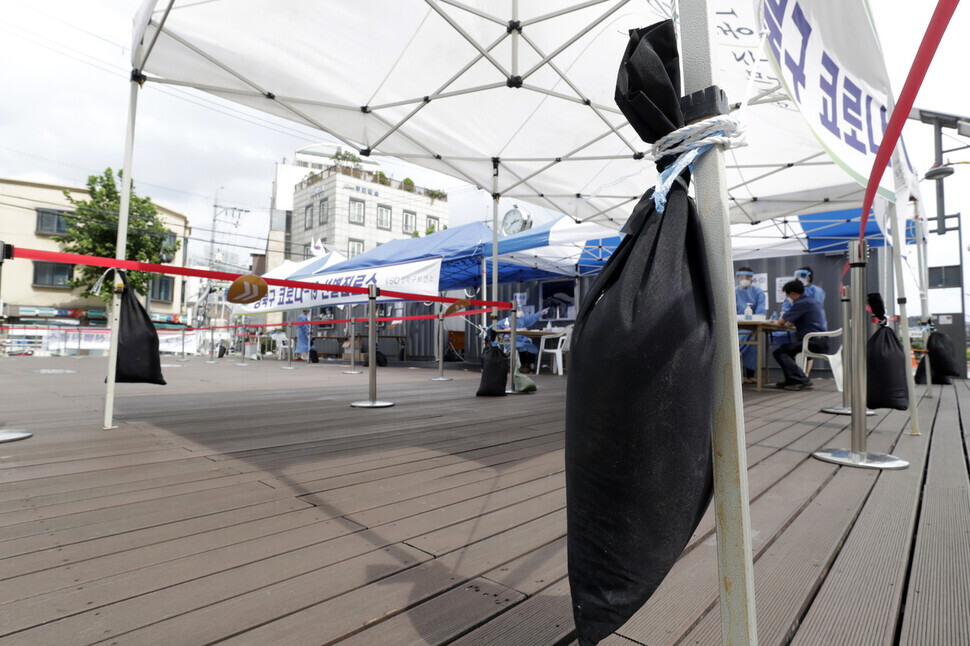hankyoreh
Links to other country sites 다른 나라 사이트 링크
S. Korea records over 300 COVID-19 cases for first time in 3 days

The number of daily COVID-19 cases topped 300 for the first time in three days on Aug. 26. In addition to numerous cases associated with previous infection clusters at Seoul’s Sarang Jeil Church and a Liberation Day demonstration at Gwanghwamun Square, cluster infections were also reported at several crowd facilities such as churches, restaurants, and public baths.
The Korea Centers for Disease Control and Prevention (KCDC) announced a total of 320 new cases for Aug. 26. It was the 13th straight day of triple-digit figures since Aug. 14. The rise remained especially sharp in the Seoul Capital Area (SCA), with Incheon in particular seeing over 60 confirmed cases that day, including 25 at the Lord’s Church in the city’s Seo (West) District alone. Congregation members and their families have been undergoing full-scale testing after a Gwanghwamun rally participant who attended services at the church tested positive on Aug. 23. Nineteen employees at a meat processing plant in Seoul’s Geumcheon District also tested positive. The transmission route is believed to have been through joint dining with an infected individual at the plant’s cafeteria last week. The Artificial Kidney Center at Hanyang University Hospital in Seoul’s Seongdong District was additionally closed temporarily after an employee tested positive.
Numerous infection clusters have been sprouting up throughout South Korea. In Gimhae, South Gyeongsang Province, the president of the Gimhae Urban Development Corporation tested positive after attending an executive meeting on Aug. 24, resulting in the closure of the city hall and its annex and city council complex. The Central Government Complex in Seoul was partially sealed off and sterilized after a second patient in two months was diagnosed there. A guide working at the Blue House’s Sarangchae government tourism and publicity center also tested positive. Confusion also erupted at the National Assembly building in Seoul’s Yeongdeungpo District after the discovery that a photojournalist covering a Democratic Party supreme council meeting had dined with a confirmed patient on Aug. 22 led to an unprecedented complete self-quarantine for all members of the party leadership.
Continuing rise of “mystery cases” with unidentified transmission routesAmid the rise in confirmed cases, the proportion of “mystery cases” with unidentified transmission routes exceeded 18%. Disease control authorities pleaded with the public to keep in-person contact to a minimum and stay at home, stressing the possibility that social distancing could be upgraded to Level 3 if the current outbreak does not subside.
“If the current outbreak doesn’t abate this week and we end up going into Level 3, the damages from that will be enormous,” explained KCDC Director Jung Eun-kyeong.
“It is crucial that everyone strongly practices social distancing,” she stressed.
Meanwhile, the KCDC announced that the strain of the COVID-19 virus associated with the recent outbreaks at Sarang Jeil Church and Woori Jeil Church in Yongin, Gyeonggi Province, belongs to the “GH strain,” the same one found in a May outbreak associated with clubs in Seoul’s Itaewon neighborhood. The World Health Organization (WHO) has classified the virus into seven strains -- including the S, V, L, G, GH, and GR clades -- with the GH strain currently prevalent in North America, Europe, and the Middle East. The GH strain’s transmissibility is reported to be roughly six times higher than those of the S and V strains. While the majority of domestic cases through April had belonged to the S and V strains, the GH strain has been spreading since the emergence of the Itaewon cluster.
By Kim Mi-na, Park Jun-yong, and Lee Ji-hye, staff reporters
Please direct comments or questions to [english@hani.co.kr]

Editorial・opinion
![[Column] Season 2 of special prosecutor probe may be coming to Korea soon [Column] Season 2 of special prosecutor probe may be coming to Korea soon](https://flexible.img.hani.co.kr/flexible/normal/500/300/imgdb/original/2024/0426/3317141030699447.jpg) [Column] Season 2 of special prosecutor probe may be coming to Korea soon
[Column] Season 2 of special prosecutor probe may be coming to Korea soon![[Column] Park Geun-hye déjà vu in Yoon Suk-yeol [Column] Park Geun-hye déjà vu in Yoon Suk-yeol](https://flexible.img.hani.co.kr/flexible/normal/500/300/imgdb/original/2024/0424/651713945113788.jpg) [Column] Park Geun-hye déjà vu in Yoon Suk-yeol
[Column] Park Geun-hye déjà vu in Yoon Suk-yeol- [Editorial] New weight of N. Korea’s nuclear threats makes dialogue all the more urgent
- [Guest essay] The real reason Korea’s new right wants to dub Rhee a founding father
- [Column] ‘Choson’: Is it time we start referring to N. Korea in its own terms?
- [Editorial] Japan’s rewriting of history with Korea has gone too far
- [Column] The president’s questionable capacity for dialogue
- [Column] Are chaebol firms just pizza pies for families to divvy up as they please?
- [Column] Has Korea, too, crossed the Rubicon on China?
- [Correspondent’s column] In Japan’s alliance with US, echoes of its past alliances with UK
Most viewed articles
- 1Is Japan about to snatch control of Line messenger from Korea’s Naver?
- 2[News analysis] Using lure of fame, K-entertainment agency bigwigs sexually prey on young trainees
- 3[Column] Park Geun-hye déjà vu in Yoon Suk-yeol
- 4Will NewJeans end up collateral damage in internal feud at K-pop juggernaut Hybe?
- 5‘We must say no’: Seoul defense chief on Korean, USFK involvement in hypothetical Taiwan crisis
- 6[Column] The clock is ticking for Korea’s first lady
- 7[Column] Season 2 of special prosecutor probe may be coming to Korea soon
- 8Korea’s 1.3% growth in Q1 signals ‘textbook’ return to growth, says government
- 9Division commander ordered troops to enter raging flood waters before Marine died, survivor says
- 10Report reveals toxic pollution at numerous USFK bases